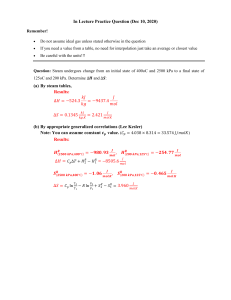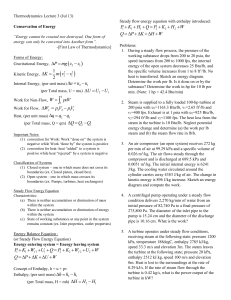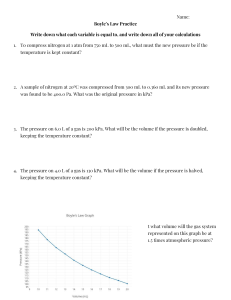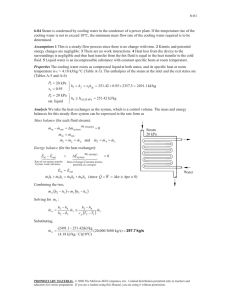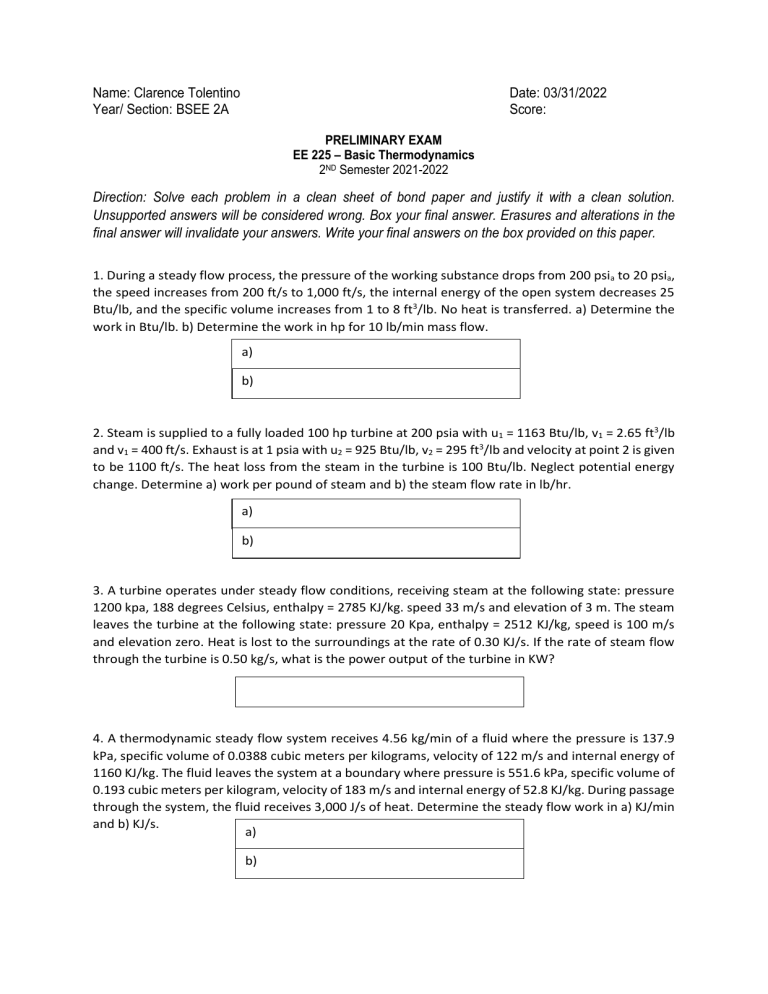
Name: Clarence Tolentino Year/ Section: BSEE 2A Date: 03/31/2022 Score: PRELIMINARY EXAM EE 225 – Basic Thermodynamics 2ND Semester 2021-2022 Direction: Solve each problem in a clean sheet of bond paper and justify it with a clean solution. Unsupported answers will be considered wrong. Box your final answer. Erasures and alterations in the final answer will invalidate your answers. Write your final answers on the box provided on this paper. 1. During a steady flow process, the pressure of the working substance drops from 200 psia to 20 psia, the speed increases from 200 ft/s to 1,000 ft/s, the internal energy of the open system decreases 25 Btu/lb, and the specific volume increases from 1 to 8 ft3/lb. No heat is transferred. a) Determine the work in Btu/lb. b) Determine the work in hp for 10 lb/min mass flow. a) b) 2. Steam is supplied to a fully loaded 100 hp turbine at 200 psia with u1 = 1163 Btu/lb, v1 = 2.65 ft3/lb and v1 = 400 ft/s. Exhaust is at 1 psia with u2 = 925 Btu/lb, v2 = 295 ft3/lb and velocity at point 2 is given to be 1100 ft/s. The heat loss from the steam in the turbine is 100 Btu/lb. Neglect potential energy change. Determine a) work per pound of steam and b) the steam flow rate in lb/hr. a) b) 3. A turbine operates under steady flow conditions, receiving steam at the following state: pressure 1200 kpa, 188 degrees Celsius, enthalpy = 2785 KJ/kg. speed 33 m/s and elevation of 3 m. The steam leaves the turbine at the following state: pressure 20 Kpa, enthalpy = 2512 KJ/kg, speed is 100 m/s and elevation zero. Heat is lost to the surroundings at the rate of 0.30 KJ/s. If the rate of steam flow through the turbine is 0.50 kg/s, what is the power output of the turbine in KW? 4. A thermodynamic steady flow system receives 4.56 kg/min of a fluid where the pressure is 137.9 kPa, specific volume of 0.0388 cubic meters per kilograms, velocity of 122 m/s and internal energy of 1160 KJ/kg. The fluid leaves the system at a boundary where pressure is 551.6 kPa, specific volume of 0.193 cubic meters per kilogram, velocity of 183 m/s and internal energy of 52.8 KJ/kg. During passage through the system, the fluid receives 3,000 J/s of heat. Determine the steady flow work in a) KJ/min and b) KJ/s. a) b) 5. Two liquids of different densities (95 lb/ft3 and 30 lb/ft3) are poured together into a 3 ft3 tank, filling it. If the resulting density of the mixture is 50 lb/ft3. (a) Find the respective amount of fluid used in US gallons (b) the total weight of the mixture in lb (c) total weight in region where local g is 30 ft/s2. a) b) c) 6. A weatherman carried an aneroid barometer from the ground floor to his office atop the Sear tower in Chicago, On the Ground level; the barometer reads 30.15 in Hg absolute; topside it reads 28.60 in Hg absolute. Assume that average atmospheric air density of 0.075 lb/ft3; estimate the height of the building, ft. 7. If a pump discharges 75 GPM of water whose specific weight is 61.5 lb/ft3 at local g= 31.9 ft/s2 , find a) Mass flow rate lb/min b) Time to fill a drum 10ft diameter and 12 ft high, min. a) b) 8. Ammonia weighing 22 kg is confined inside a cylinder equipped with a piston has an initial pressure of 413 kPa at 38 oC. If 2900 KJ of heat is added to the ammonia until its pressure and temperature are 413 kPa and 100 oC, respectively. What is the amount of work done by the fluid in KJ? 9. A large mining company was provided with a 3000 cm3 of compressed air tank. Air pressure in the tank drops from 700 kPa to 180 kPa while the temperature remains unchanged at 28 oC. What percentage has the mass of air in the tank been reduced? 10. A certain gas at 101.325 kPa and 16 oC whose volume is 2.83 m3 are compressed into a storage vessel of 0.31 m3 capacity. Before admission, the storage vessel contained the gas at a pressure and temperature of 137.8 kPa and 24 oC. After admission, the pressure has increased to 1171.8 kPa. What should be the final temperature of the gas in the vessel in Kelvin?
